BIOS functionality
In our previous reviews about the Asus
products we have already mentioned about Asus EFI BIOS - a highly successful
overall implementation of the UEFI standard (Unified Extensible Firmware
Interface). So, today we will shortly refresh the memory in the basic BIO
sections and their parameters and settings.
By default, the "EZ Mode" is
enabled in the BIOS. It performs the principal function is to provide
information, because there are not almost any configurable parameters there.
You are likely to check the basic system settings, a number of monitoring data,
choose an energy saving or performance modes and establish the order of boot-up
devices by simply dragging and dropping them to cursor.
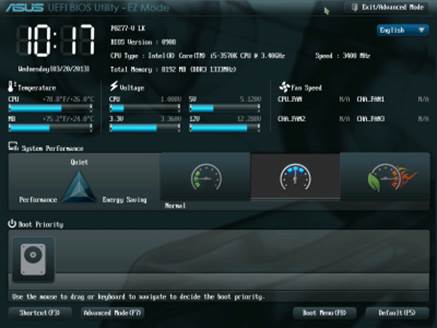
The
BIOS boot-up screen
You are able to quickly change from the
"EZ Mode" to "Advanced Mode" by pressing F7, or use the F3
hot key to jump over to one of the most commonly used BIOS sections.
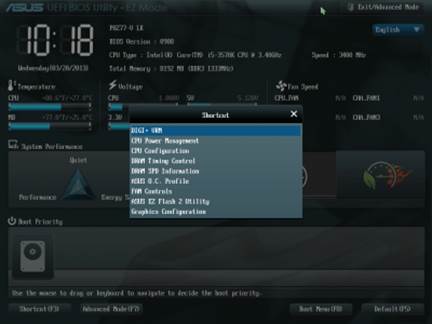
“Advanced
Mode”
You are able to change from the "EZ
Mode" to "Advanced Mode" every time you come in the BIOS, or
press the F3 key that is going to work if it is pressed in any of the other
BIOS section, but it would be likely to be much more convenient if you had the
"Advanced Mode" in a default setting mode. In this case, the first
thing you see will be the familiar "Main" section, where you can get
some basic system information, change the interface language and set up the
date and time.
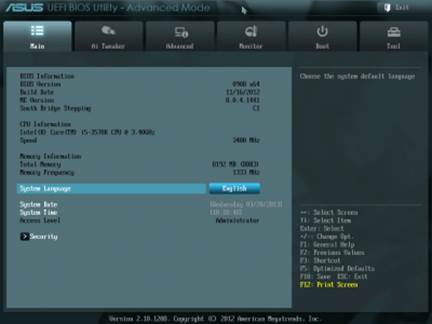
The
basic system information
Most of the overclocking related the
options are collected in the traditional way in the "Ai Tweaker"
section. The main window of this section lets you change the frequencies,
multipliers and voltages. You do not need to go through the
"Monitoring" section to check the current voltages; since all of them
are listed here next to each parameter used to change the voltages, which is
very convenient. The voltages can be set above or below their nominal values.
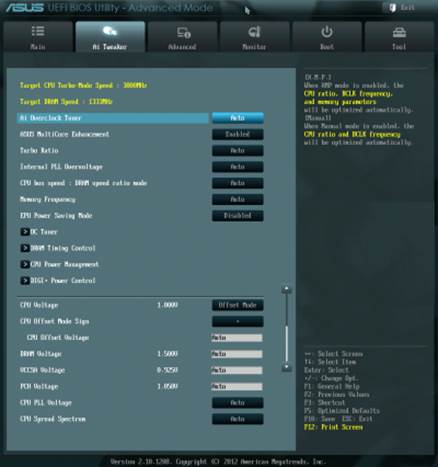
Changing
the voltage
As usual, a number of parameters are
separated into individual components to remove the main section. The "OC
Tuner" parameter looks like a sub-section, but in fact it helps to
automatically overclock the system. The memory timings are likely to be
configured on an individual page. They actually have a lot of numbers, but are
still very easy to work with. You are able to see all of the timings that the
mainboard sets for each of the two memory channels. And you are able to adjust
only several opted timings, like the power lines, for instance, keeping all
other settings at defaults.
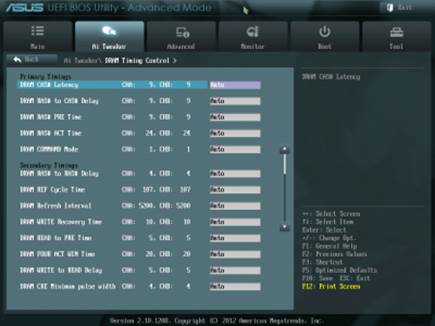
The
"OC Tuner" parameter
The "CPU Power Management"
sub-section allows configuring the parameters that affects the "Intel
Turbo Boost" technology. However, you do not need to do that, since the
mainboard will automatically adjust everything to fit the goals of your
overclocking options.
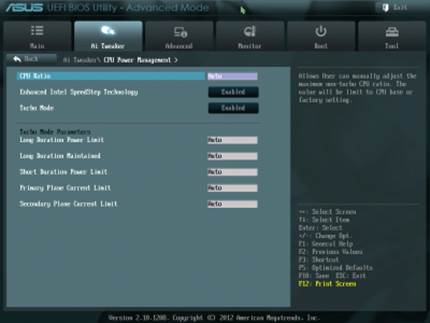
The
"CPU Power Management" sub-section
The number of options related to the power
and energy-efficiency of the digital DIGI+ voltage has considerably been
reduced, but all of the most important parameters are still there. You are able
to configure the exclusive power- saving technologies of Asus that allow
changing the amount of the operational phases in the voltage regulator circuits
depending on the CPU usage even in the BIOS. "CPU Load-Line
Calibration" technology that is to prevent the CPU Vcore from being
dropped under heavy load can be enabled or disabled, but also adjusted to
provide the desired effect.
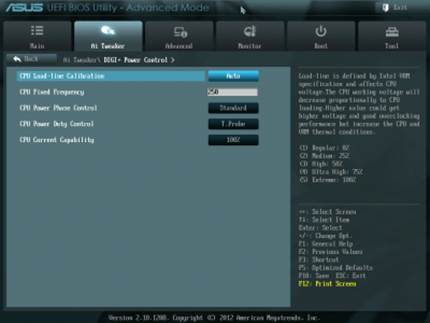
"CPU
Load-Line Calibration" technology
The functions of the parameters in the sub-sections
of the "Advanced" can be self-explanatory.
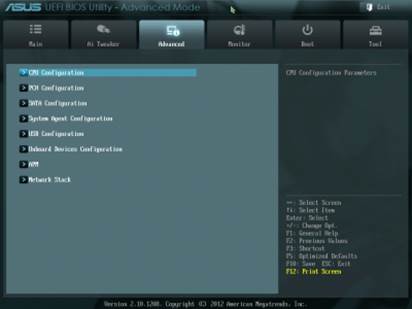
The
"CPU Configuration" sub-section
The "CPU Configuration"
sub-section reports the basic information about the processor and allows you to
manage a number of processor technologies.
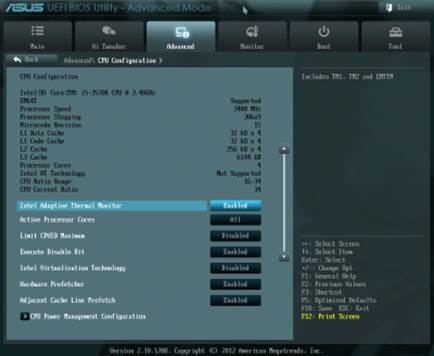
The
"CPU Configuration" sub-section
All parameters related to power-saving are
shown on a separate page called "CPU Power Management Configuration".
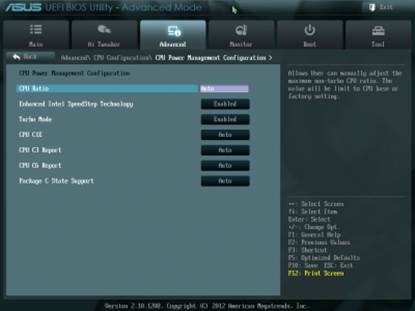
“CPU
Power Management Configuration”
The "Monitor" section lets us
know the current temperatures, the voltages and fan dial speeds. You are able
to opt for one of the preset modes for the processor and two system fans from a
fairly standard list that includes the "Standard", "Silent"
and "Turbo" modes. You can also opt for the parameters manually.
Unfortunately, both of the processor fans can only be adjusted if they use
four-pin connectors.
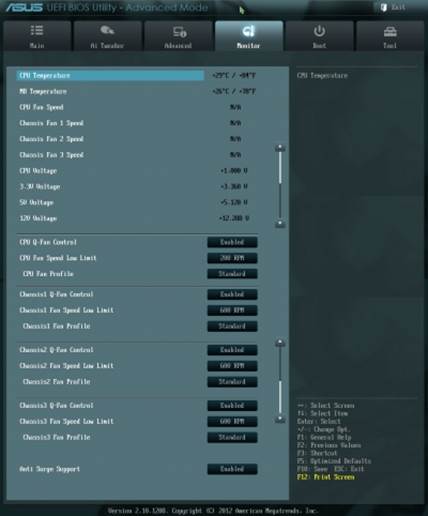
The
"Monitor" section
The "Boot" section allows you to
adjust the boot-up parameters that will be applied on star-tup system. By the
way, this is where you will have to replace the default "EZ Mode"
with "Advanced Mode".
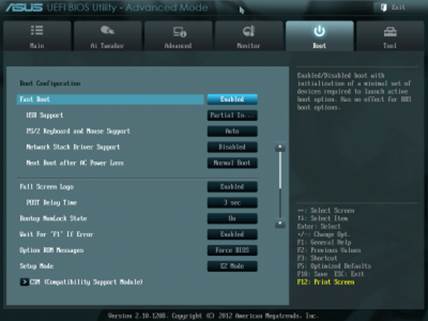
“Advanced
Mode”
Now let's take a quick refresh the
functions of the "Tools" section.
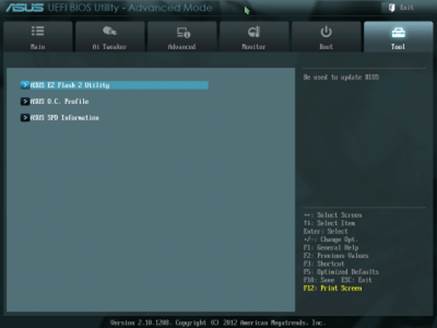
The
"Tools" section
Integrating the "EZ Flash 2"
utility for the BIOS reflashing process is one of the most convenient and most
useful programs of all. Unfortunately, they have removed the options that allow
saving the current BIOS version before reflashing a new one.
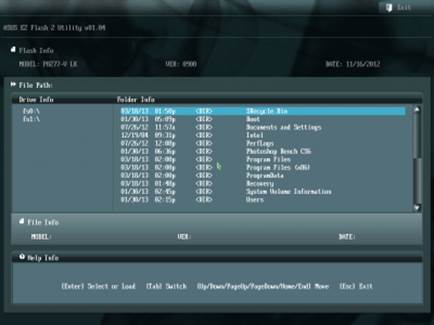
The
"EZ Flash 2" utility
The Asus mainboards allow saving and then
quickly downloading eight full BIOS settings configurations. Each configuration
can be provided by a brief descriptive name to remind you of its contents. They
still have not repaired the problems that do not allow you to save disabling
contents of the boot-up image in settings configuration, but they brought back
the ability to swap the BIOS settings configurations with the other users,
which failed when converting to the EFI BIOS. From now, the configurations can
be saved into the external media and reloaded from them.
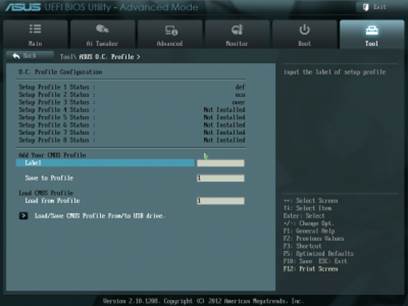
Converting
to the EFI BIOS
Like on the mainboards from many other
manufacturers, we are able to read the information in the SPD memory modules,
including the XMP (Extreme Memory Profiles).
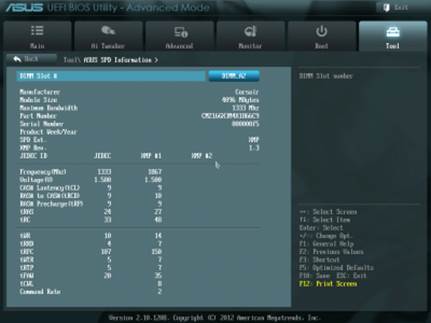
Extreme
memory profiles
The final section is called
"Exit". Here you are able to apply the changes, or restore the
defaults or return to the "EZ Mode".
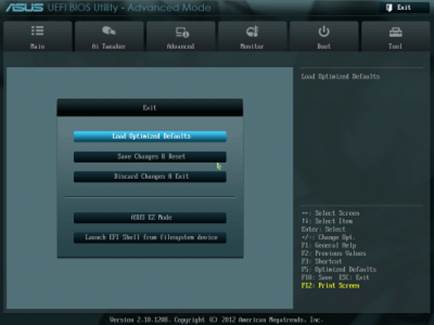
The
"Exit" final section
Test configuration
We conducted all of our tests based on the
components below:
·
Intel Core i5-3570K CPU (3.6-3.8 GHz, 4 cores,
rev.E1 Ivy Bridge, 22nm, 77 W, V 1:05, LGA 1155);
·
2 x 4 GB Corsair Vengeance CMZ16GX3M4X1866C9R
DDR3 SDRAM (1866 MHz 9-10-9-27 timings, voltage 1.5 V);
·
Gigabyte GV-R797OC-3GD graphics card (AMD Radeon
HD 7970, Tahiti, 28 nm, 1000/5500 MHz, 384-bit GDDR5 3072 MB);
·
Crucial m4 SSD (CT256M4SSD2, 256 GB, SATA 6
Gbps);
·
Noctua NH-D14 CPU cooler;
·
ARCTIC MX-2 thermal interface;
·
Enhance EPS-1280GA 800 W PSU;
·
Antec skeleton case
We used the Microsoft Windows 8 Enterprise
64-bit operating system (Microsoft Windows, version 6.2, Build 9200) Intel
Chipset Drivers version 9.3.0.1026, AMD Catalyst graphics card driver version
13.1.